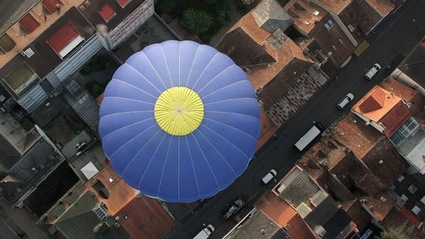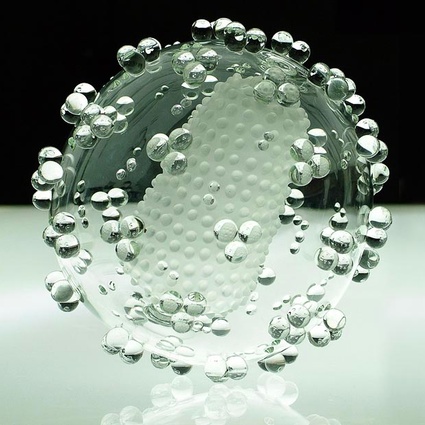 Human immunodeficiency virus (HIV)
Human immunodeficiency virus (HIV)
Back to the chaotic notes i’ve been taking during Making Visible The Invisible, a conversational conference about interdisciplinary collaboration, data-visualisation and sustainability, curated by Michael Hohl with the support of the University of Huddersfield, School of Art, Design and Architecture. One of the first keynotes of the conference was given by artist Luke Jerram.
Jerram credits the fact that he is colour-blind for his interest in perception. This interest takes many forms: a kinetic sound installation controlled by the movements of the Moon and Sun, a miracle toaster, an engagement ring etched with a 20 second recorded message that can be played back with a miniature record player, street pianos left for the public to play in parks and squares, laundrettes, bus shelters and train stations, across the world, etc. His most spectacular and also perhaps most well-known exploration into perception is Sky Orchestra, a series of performances in which hot air balloons fly over a city at dawn and broadcast music designed to turn the dreams of the sleeping public into an artistic experience. The idea was fine-tuned with the Dream Concert experiment and the Dream Director installation. There is a lot to like and write about in his portfolio but i’ll just focus on two of his most recent projects: Glass Microbiology and Aeolus – Acoustic Wind Pavilion.
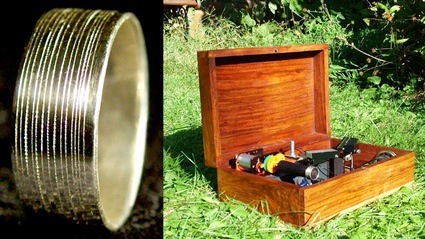 Talking Ring
Talking Ring
Glass Microbiology is a growing series of glass sculptures of viruses and bacteria. He worked with Dr Andrew Davidson from the University of Bristol to create accurate representation of HIV, E. coli, SARS, H1N1 and even imaginary viruses.
The result is radically different from the images of a virus we get in scientific publications. Science papers and articles are usually illustrated with colourful images of viruses. A virus, however, is far too small to have any colour. Although Jerram’s sculptures are approximately one million times larger than the viruses they represent, their transparency makes them closer to reality.
The Genetics Science Learning Center, University of Utah, has made a neat animation that illustrates how tiny E. coli bacterium, HIV, influenza virus are compared to other objects such as a coffee bean:
The artist recently sold one of his glass microbe to the Wellcome Trust. Interestingly, the foundation decided to add colours to the photos of the transparent sculpture they sent to the press to inform them about the artwork.
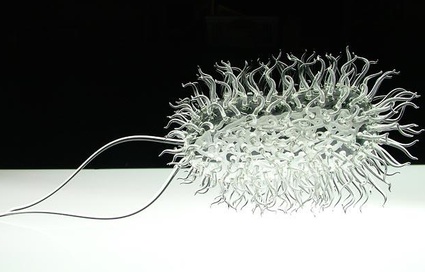 E-coli
E-coli
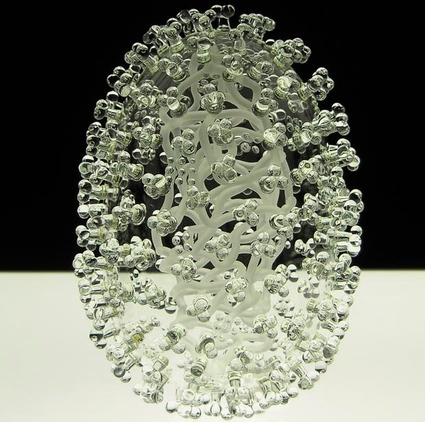 H1N1 Swine Flu
H1N1 Swine Flu
Unsurprisingly, Jerram’s sculptures sparkled the interest of the scientific community. Many scientific publications used images of the glass sculptures to illustrate articles about viruses. One of them asked Jerram if they could use a photo of one of his viruses to illustrate an article about HIV. Curiously, they didn’t use the sculpture of the HIV virus. Instead, they chose an image of the swine flu virus because, they argued, it made for a more ‘striking’ cover.
Malaria parasite (Plasmodium falciparum Merozoite) sculpture respresenting the Merozoite after it has entered a red blood cell
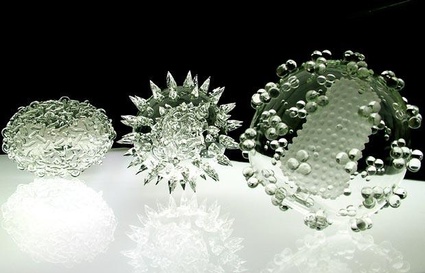 From Left to right a smallpox variant, a mutant pathogen (imagined by the artist) and HIV
From Left to right a smallpox variant, a mutant pathogen (imagined by the artist) and HIV
Smallpox is one of the two infectious diseases to have been eradicated, the other being rinderpest, which was officially declared eradicated this year. Smallpox has killed more humans than any other virus in human history. It is estimated that disease was responsible for the death of 300-500 million people during the 20th century.
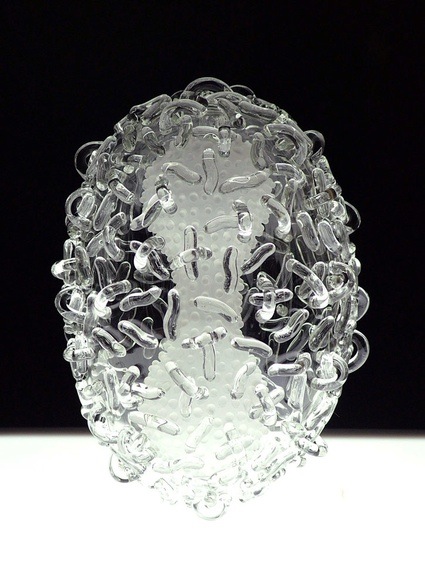 Smallpox virus
Smallpox virus
In 2007, Jerram was visiting Iran when he discovered some strange-looking mole hills spread across the landscape. The hills are the ventilation shafts of the qanats, ancient underground aqueducts that provide water to human settlements and for irrigation. While talking with a well digger, Jerram was told that the wind makes these ventilation shafts ‘sing.’
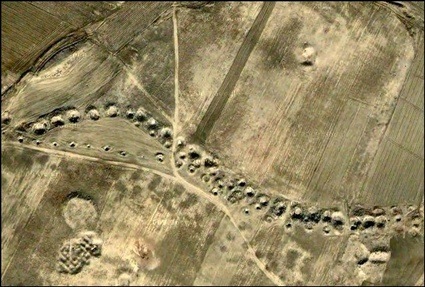 A qanat near Anšan, seen from the air (Google Earth)
A qanat near Anšan, seen from the air (Google Earth)
 Cross-section of a Qanat
Cross-section of a Qanat
The phenomenon gave the artist the inspiration for one of his ongoing projects. He wants to create buildings that sing in the wind! He is currently working with engineers at ARUP to develop the Aeolus – Acoustic Wind Pavilion. One of the most interesting comments he made about the project is:
“The reason why i like working with analog technology is that it leave plenty of space for nature to inject some surprises. You never know what you’re going to get exactly at the end of the experiments.”
One of the surprises he referred to is that the sound produce by his experiment evokes the landing of an UFO:
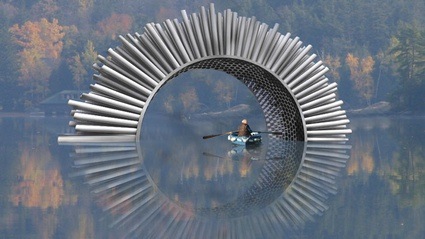 Photoshop mock up of Aeolus in landscape
Photoshop mock up of Aeolus in landscape
Aeolus is an acoustic and optical pavilion shaped like an arch. Once inside, a viewer can look out through a field of 310 internally polished stainless steel tubes simultaneously, each of which draws the landscape of light through the structure whilst humming at a series of low frequencies. These light pipes act to frame, invert and magnify the landscape around the pavilion enabling the viewer to contemplate an ever changing landscape of light. As the clouds and sun move across the sky throughout the day, the visual experience for the public will dramatically alter minute by minute, hour by hour.
Listening to the landscape of wind. Aeolus is designed to resonate and sing with the wind without any electrical power or amplification. Aeolus will sonify the three dimensional landscape of wind, using a web of Aeolian harps. Almost like cats’ whiskers sensitive to the slightest touch, the stings register the shifting landscape of wind around the artwork will be heard by visitors.
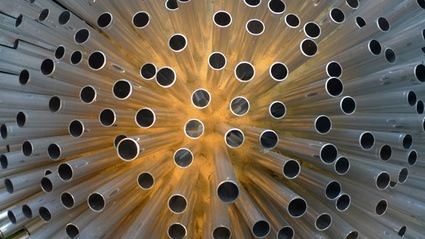 Close up of prototype
Close up of prototype
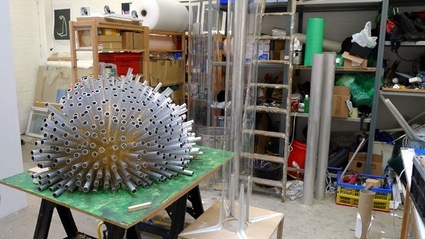 Aeolus – Prototype in studio
Aeolus – Prototype in studio
Once completed, the artwork will tour the UK. Its first stop will be in Liverpool for the art biennial.
Also part of the conference: Andrea Polli – “Who Owns The Air?”

